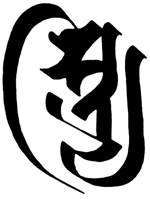visits to the site - 154,519; up 62% from 2008
page loads - 484,360; up 30% from 2008
Most popular mantra - Vajrasattva - 22,315 pageloads. Also no.1 2008.
The Facebook Visible Mantra page now also has 1003 fans.
Thanks everyone for making this website a success.
31 December 2009
17 December 2009
Offering Mantra
Gino recently asked about the offering mantra used during the maṇḍala offering practice. I thought other people might be interested in this as well.
The mantra reads:
If we take this to be a Sanskrit sentence then the words guru and ratna are undeclined suggesting that they are part of a compound: gururatnamaṇḍalakaṃ. So how should be parse this compound? Firstly the individual words: guru = teacher; ratna = jewel; maṇḍalaka is a variant of maṇḍala. The -ṃ ending would appear to match the idaṃ and be an accusative making idaṃ gururatnamaṇḍalakaṃ the object of the verb. I suggest that we take ratnamaṇḍalaka to be a tatpuruṣa - maṇḍala of jewels. Then it would make some sense for this to make a tatpuruṣa with 'guru', but perhaps of the dative kind, 'to or for the guru' rather than the standard genitive 'of the guru'. Looking at the context I think this fits what is being done in practice.
The verb comes from the root √yat 'to stretch'. What we have here is a causative form: yātayati which can mean 'to suffer', or in this case 'to yield up' or 'surrender'. The first person singular is yātayāmi 'I surrender'. The addition of the prefix nir- here indicates that one is giving up to others. Of Monier-Williams' suggestions 'to give back, to restore' seem to fit the context, he notes the sense of 'to give as a present' in the Lalitavistara Sūtra.
So we could render the phrase
The mantra reads:
idaṃ guru-ratna-maṇḍalakaṃ niryātayāmi
इदं गुरुरत्नमण्डलकं निर्यातयामि
(above in dbu-can)
इदं गुरुरत्नमण्डलकं निर्यातयामि
(above in dbu-can)
If we take this to be a Sanskrit sentence then the words guru and ratna are undeclined suggesting that they are part of a compound: gururatnamaṇḍalakaṃ. So how should be parse this compound? Firstly the individual words: guru = teacher; ratna = jewel; maṇḍalaka is a variant of maṇḍala. The -ṃ ending would appear to match the idaṃ and be an accusative making idaṃ gururatnamaṇḍalakaṃ the object of the verb. I suggest that we take ratnamaṇḍalaka to be a tatpuruṣa - maṇḍala of jewels. Then it would make some sense for this to make a tatpuruṣa with 'guru', but perhaps of the dative kind, 'to or for the guru' rather than the standard genitive 'of the guru'. Looking at the context I think this fits what is being done in practice.
The verb comes from the root √yat 'to stretch'. What we have here is a causative form: yātayati which can mean 'to suffer', or in this case 'to yield up' or 'surrender'. The first person singular is yātayāmi 'I surrender'. The addition of the prefix nir- here indicates that one is giving up to others. Of Monier-Williams' suggestions 'to give back, to restore' seem to fit the context, he notes the sense of 'to give as a present' in the Lalitavistara Sūtra.
So we could render the phrase
idaṃ guru-ratna-maṇḍalakaṃ niryātayāmi
I offer up this jewel-maṇḍala to the guru
I offer up this jewel-maṇḍala to the guru
Labels:
Mantra
15 December 2009
Tendai Studies and Art Symposium
If you live in California then this is an amazing opportunity to hear and meet some of the great names in Buddhist studies including John Stevens author of Sacred Calligraphy of the East (without which none of this website would exist!). There will be an exhibit of Tendai calligraphy from April 1 to June 1 2010.
07 December 2009
Stryi and the Karaṇḍamudrā Dhāraṇī
 Back in Feb 2009 I was intrigued by a complex seed-syllable seen carved on the side of a Japanese stūpa. I could see the Siddhaṃ elements but wanted to understand the context. Eventually, with a little luck, I managed to identify the bīja as stryi which is associated with an important Japanese liturgical text: the Karaṇḍamudrā Dhāraṇī. I put some notes into this blog, but have now put this material on its own page: Karaṇḍamudrā Dhāraṇī and stryi.
Back in Feb 2009 I was intrigued by a complex seed-syllable seen carved on the side of a Japanese stūpa. I could see the Siddhaṃ elements but wanted to understand the context. Eventually, with a little luck, I managed to identify the bīja as stryi which is associated with an important Japanese liturgical text: the Karaṇḍamudrā Dhāraṇī. I put some notes into this blog, but have now put this material on its own page: Karaṇḍamudrā Dhāraṇī and stryi.At some point I want to do some Siddhaṃ calligraphy of the dhāraṇī itself, but here at least you can see where the syllable stryi originates from.
Some other versions of stryi can be seen in this Flickr Gallery: Stone Siddhaṃ.
Subscribe to:
Comments (Atom)

